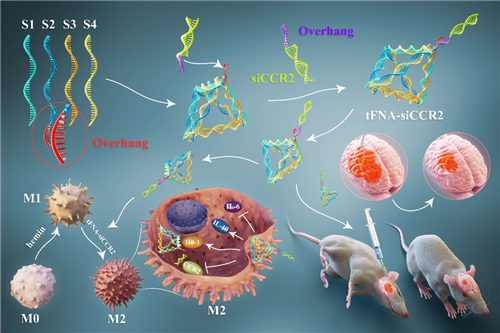In collaboration with Prof. Yunfeng Lin's team from West China Medical Center of Sichuan University, Prof. You Chao’s team from West China Hospital of Sichuan University published a research paper entitled "Therapeutic Siccr2 Loaded by Tetrahedral Framework DNA Nanobiology in Therapy for Intracranial Hemorrhage" in Advanced Functional Materials (IF: 18.8, nature index). The researchers revealed that DNA tetrahedral frame nucleic acid can effectively carry siRNA to treat intracranial hemorrhage and reduce the loss of motor nerve function. The paper was also selected as the cover article of the magazine.

Fig.1.Advanced Functional Materials Vol. 31. No.33 August 2021
At present, one of the urgent problems in the treatment of intracranial hemorrhage (ICH) is how to develop corresponding adjuvant drugs while ensuring the effect of surgical treatment. In recent years, the survival rate of ICH patients has improved due to the improvement of surgical methods and medical equipment. However, the disability rate is still high.“Modulating microglial polarization is a potential strategy to assuage secondary brain injury caused by intracranial hemorrhage (ICH). However, despite decades of effort, effective therapies targeting microglia for ICH are still lacking. Here, a nanorobotic, tetrahedral framework nucleic acid (tFNA), is successfully synthesized and designed to carry C-C chemokine receptor 2 (siCCR2) for use in in vitro hemin-induced and in vivo collagenase-induced ICH models. This nanoscale complex (tFNA-siCCR2), which possesses biocompatibility, editability, and structural stability, exhibits a favorable effect in inhibiting the expression ofCCR2. After treatment with tFNA-siCCR2, hematoma absorption is accelerated, and neurological inflammation is mitigated by decreasing levels of proinflammatory cytokines, while increasing the release of anti-inflammatory factors. Consequently, the neurological deficits of mice with ICH improve. These results indicate that inhibiting CCR2 expression during the acute phase of ICH polarizes microglia towards a therapeutic subtype, and restores neurological function, which demonstrates that tFNA has a promising ability to transfer siCCR2 for treating ICH.” (Abstract)

Fig. 2. Overall schematic diagram of the paper
Wei Fu, a research associate in the Department of Neurosurgery of West China Hospital, is the first author of the paper. Chao You and Yunfeng Lin are the corresponding authors, and West China Hospital of Sichuan University is the first work unit.
https://onlinelibrary.wiley.com/doi/10.1002/adfm.202101435
